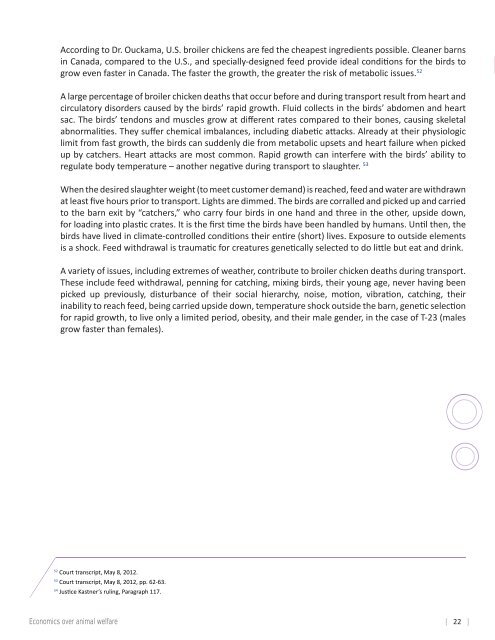Create successful ePaper yourself
Turn your PDF publications into a flip-book with our unique Google optimized e-Paper software.
According to Dr. Ouckama, U.S. broiler chickens are fed the cheapest ingredients possible. Cleaner barns<br />
in Canada, compared to the U.S., and specially-designed feed provide ideal conditions for the birds to<br />
grow even faster in Canada. The faster the growth, the greater the risk of metabolic issues. 52<br />
A large percentage of broiler chicken deaths that occur before and during transport result from heart and<br />
circulatory disorders caused by the birds’ rapid growth. Fluid collects in the birds’ abdomen and heart<br />
sac. The birds’ tendons and muscles grow at different rates compared to their bones, causing skeletal<br />
abnormalities. They suffer chemical imbalances, including diabetic attacks. Already at their physiologic<br />
limit from fast growth, the birds can suddenly die from metabolic upsets and heart failure when picked<br />
up by catchers. Heart attacks are most common. Rapid growth can interfere with the birds’ ability to<br />
regulate body temperature – another negative during transport to slaughter. 53<br />
When the desired slaughter weight (to meet customer demand) is reached, feed and water are withdrawn<br />
at least five hours prior to transport. Lights are dimmed. The birds are corralled and picked up and carried<br />
to the barn exit by “catchers,” who carry four birds in one hand and three in the other, upside down,<br />
for loading into plastic crates. It is the first time the birds have been handled by humans. Until then, the<br />
birds have lived in climate-controlled conditions their entire (short) lives. Exposure to outside elements<br />
is a shock. Feed withdrawal is traumatic for creatures genetically selected to do little but eat and drink.<br />
A variety of issues, including extremes of weather, contribute to broiler chicken deaths during transport.<br />
These include feed withdrawal, penning for catching, mixing birds, their young age, never having been<br />
picked up previously, disturbance of their social hierarchy, noise, motion, vibration, catching, their<br />
inability to reach feed, being carried upside down, temperature shock outside the barn, genetic selection<br />
for rapid growth, to live only a limited period, obesity, and their male gender, in the case of T-23 (males<br />
grow faster than females).<br />
52<br />
Court transcript, May 8, 2012.<br />
53<br />
Court transcript, May 8, 2012, pp. 62-63.<br />
54<br />
Justice Kastner’s ruling, Paragraph 117.<br />
Economics over animal welfare [ 22 ]


